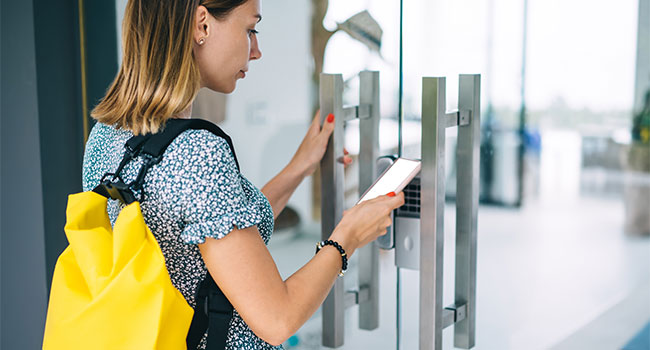
Access Control and Visitor Management: The Power of Integration
- By Jeff Bransfield
- February 01, 2022
The pandemic significantly accelerated the worldwide digital transformation we see across various markets. Fortunately, this transformation has also made way for innovative products that have reduced the need for physical devices and in-person contact. The physical security market today has expanded to include and address the User Experience (UX) and access control solutions capable of promoting various new building services such as visitor management accessed through multiple devices, including mobile phones.
These new technologies have propelled a discussion surrounding best products and practices when integrating with security backbones like access control and video surveillance. A new emerging trend is the integration of visitor management systems into access control. In this article, we will look at two examples of access control integration and its impact on the organization.
The Integration Trend
While there has been a significant push for integration across the security industry, it has been incredibly relevant in the access control market. When third-party systems are integrated with access control, there are numerous benefits, including the simplicity in adopting converged credentials. Users are less likely to lose combined credentials, ultimately saving money for the organization.
Security integration often helps keep the organization in sync while offering various benefits. Organizations typically select a multi-layered approach, and the more layers within the security infrastructure, the more challenging it is to break through them. Ultimately, the company's needs will determine what systems are integrated into their infrastructure.
Integrated systems work and function together. For example, when access control and video surveillance systems are integrated, users can use timestamps from the access control system to match an individual on video, strengthening the uses of both systems. Integration is such a highly sought-after trend because of the sheer amount of work it takes for security systems to be working in a silo on the individual system and any supporting IT or security team on-site.
Security system integration simplifies monitoring and reporting while bolstering security, reducing errors, adding convenience, and lowering an organization's total costs.
Example 1
George Mason University is home to more than 35,000 students, a 670-acre residential campus, and over 170 buildings. Over the years, GMU has invested in building new facilities across the campus, including faculty/staff housing, research buildings, residence halls, and conference centers. One central recurring theme the university faced was the need for physical security and access control.
Because of the sheer number of individuals that cross campus daily—whether staff, students, or visitors—GMU needed scalability and functionality above all else. That is one of the main reasons they chose the access control system. This access control system was easily integrated with the existing VMS and visitor management system, among many other third-party systems, and had an incredibly simple interactive map feature. Because of the system's flexibility, all integration objectives were achieved, video surveillance and visitor management were streamlined, and GMU received a scalable system that has grown and will continue to grow with the university.
The Power of Visitor Management
Certain manufacturers offer open-platform access control solutions and have software that allows security leaders to integrate a facility's access control, video, intercom, intrusion detection, alarm monitoring systems, and visitor management systems. These systems are ideal for a larger, multi-site or global organization, and they can also support visitor management.
Traditional visitor management systems allow the security team to electronically scan a visitor's ID (business card or driver's license) and capture all relevant info about them in a database. This enables them to print a visitor badge with the access level assigned.
While a standalone visitor management system significantly improves any paper system in distinguishing visitors, it's become apparent in this digital age of transformation that organizations need to adopt a holistic approach to on-site security. Visitor management and access control integration strengthens security and improves business operations.
Not only does the integration between visitor management and access control allow for visitor movements to easily be tracked and credentials to be quickly be given and revoked. Integration can also become necessary when escorts are not available, and the visitor or contractor must move through the building on their own.
Example 2
Monitoring visitors is essential for any business, but data centers especially require unique security solutions to protect their customer's most critical assets. LightEdge, a provider of cloud and colocation services in the midwestern United States, needed a new access control solution that was in line with the organization's high-level needs for security and future-proofing design.
In 2018, LightEdge sought to standardize biometrics for a unique security application for employees and visitors. Before modernizing their access control, LightEdge used a hand geometry-based system to activate visitor cards as part of their check-in process.
The new access control system needed to provide access for hundreds of people, including data center employees, visitors, and tenants across each of the seven locations. The solution also needed to be flexible and integrate with existing systems.
LightEdge ultimately chose an access control solution that was future-focused and would supply them with the highest level of security possible. Integration was necessary for the organization as they needed a smooth transition from the old system to the new one. The system also needed to be easily integrated with the visitor management system to ensure that both visitors and employees could enjoy a safe, seamless, and convenient experience.
Conclusion
Gone are the days of siloed security systems. Now, the process is fully streamlined for everyone involved. The integration of access control and third-party systems such as visitor management, video surveillance, and others will strengthen an organization's infrastructure and serve as a cost-effective, touchless, convenient, and scalable option that will serve an organization for years to come.
This article originally appeared in the January / February 2022 issue of Campus Security Today.